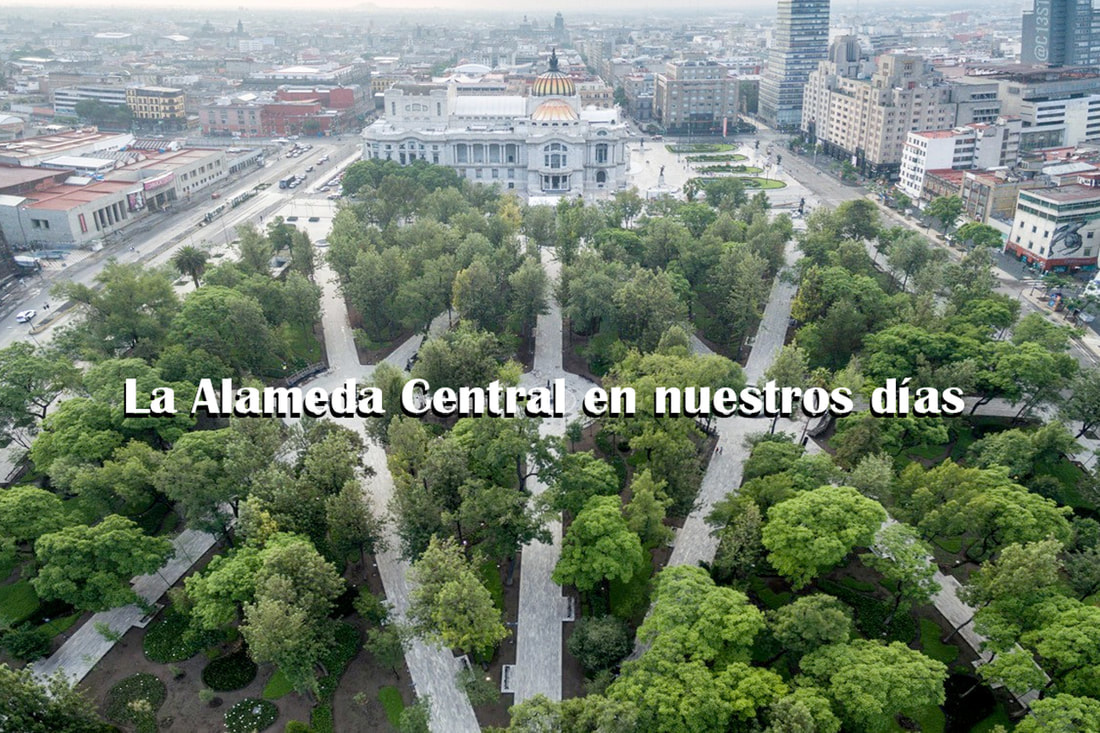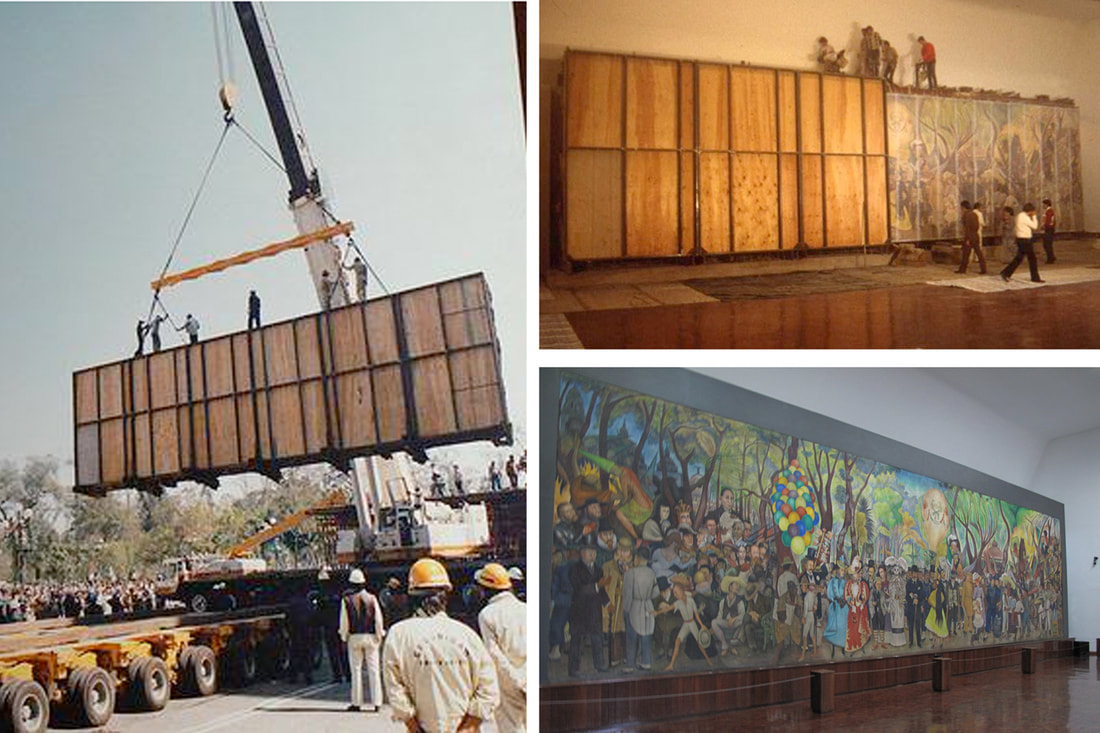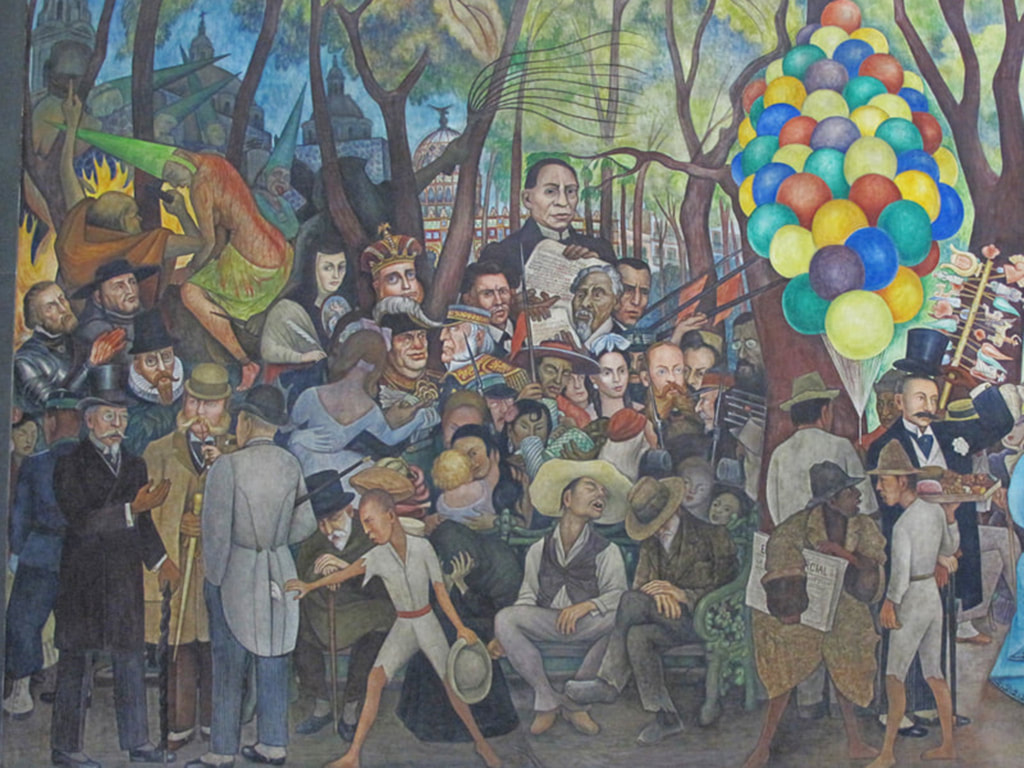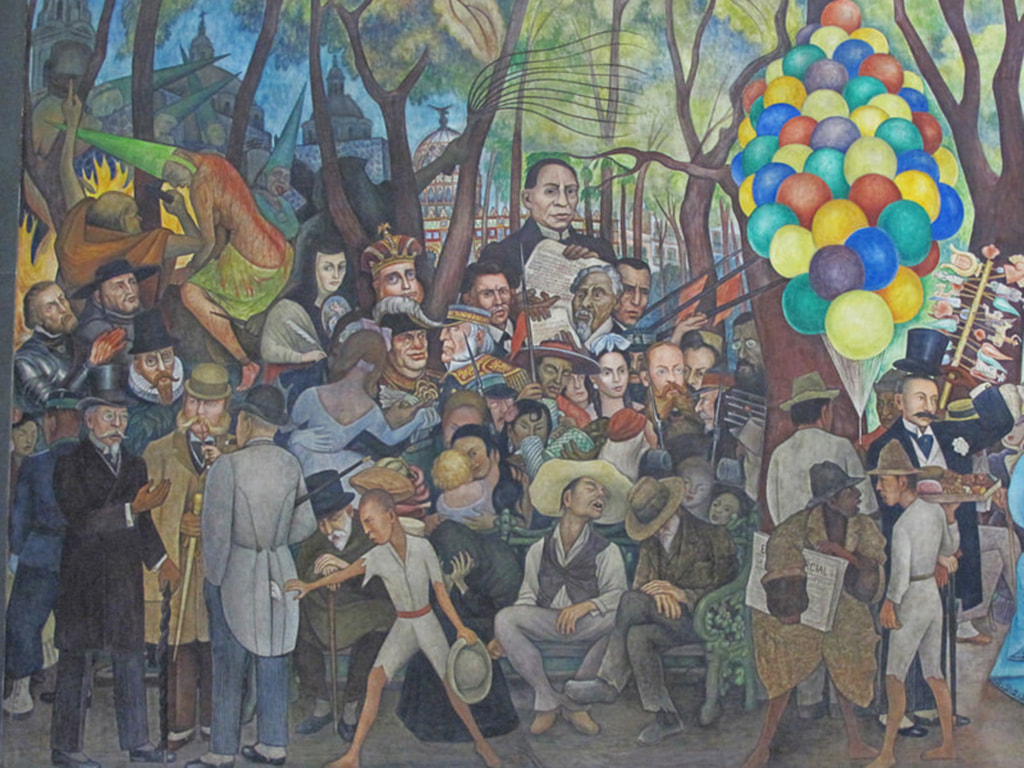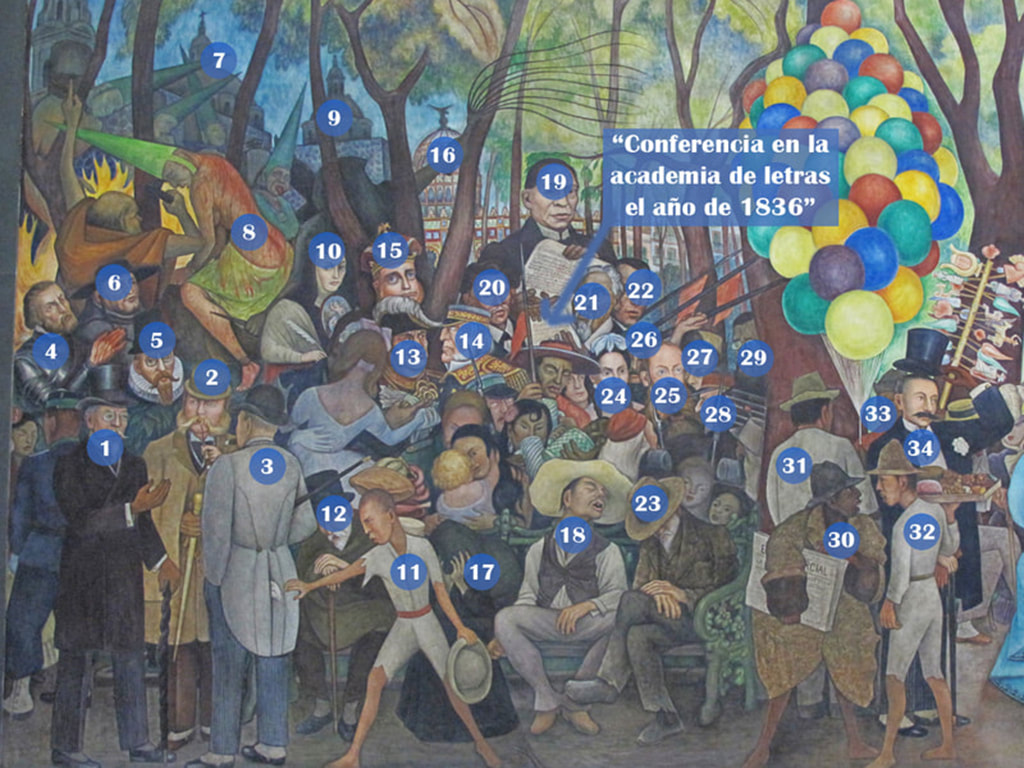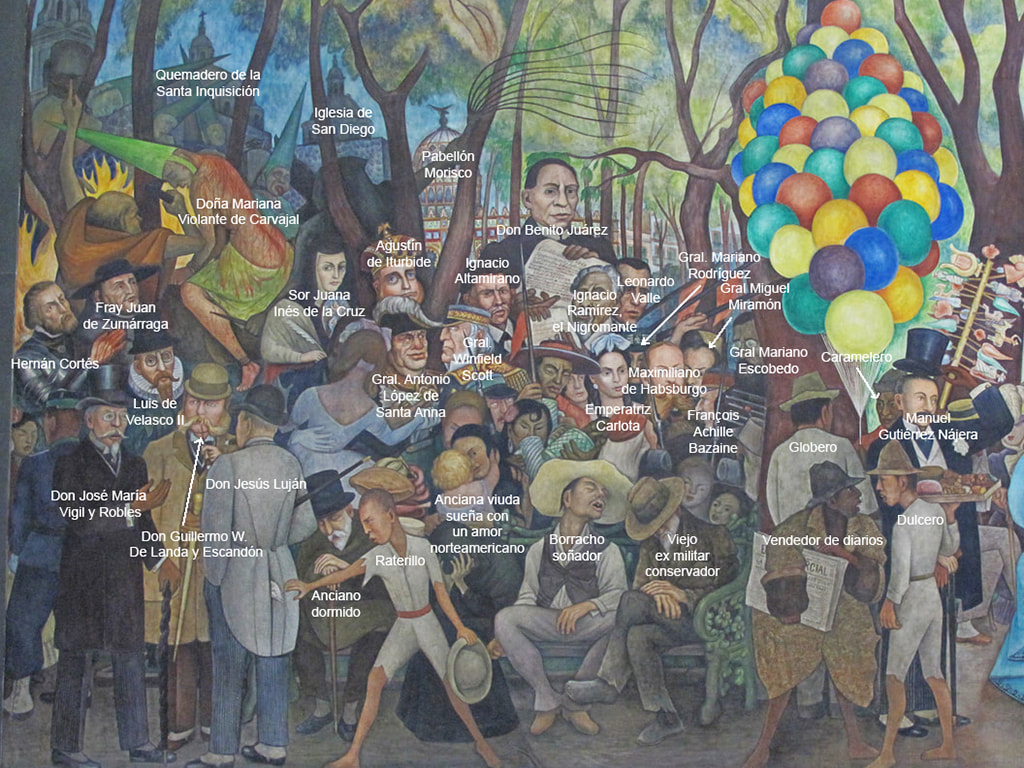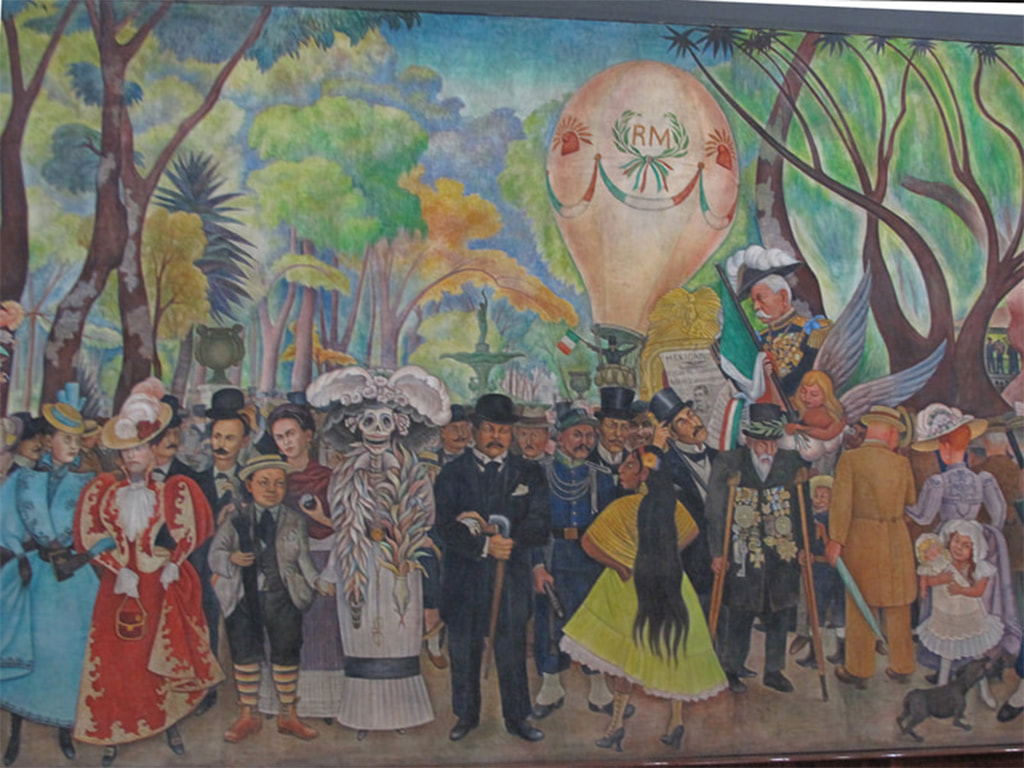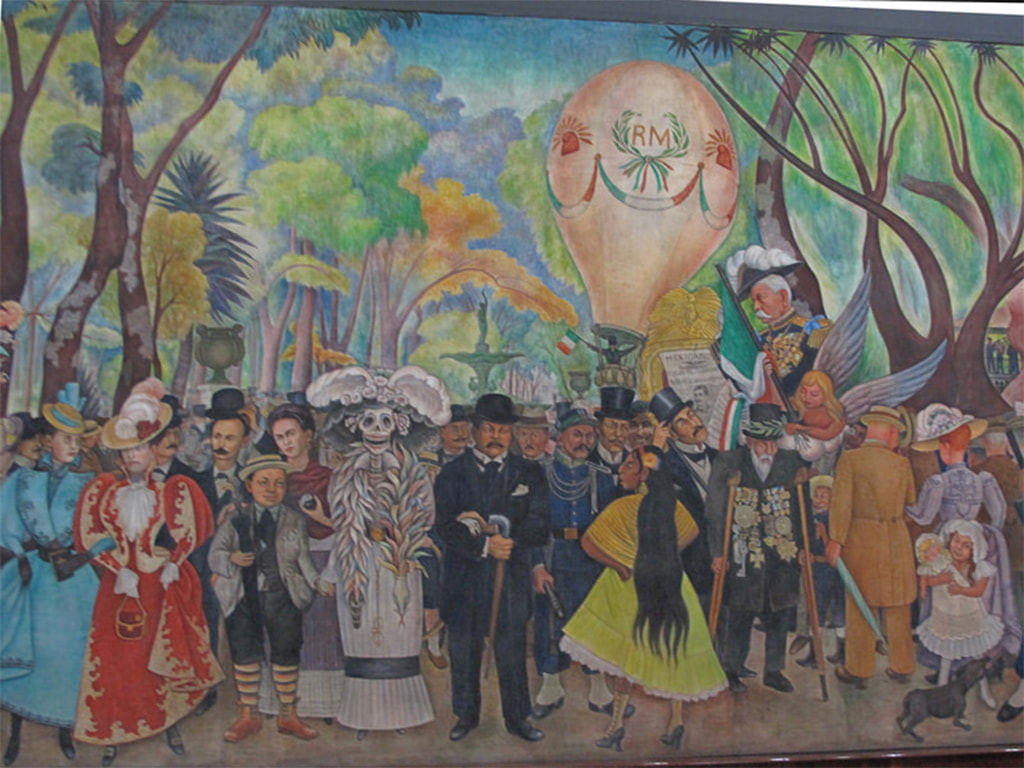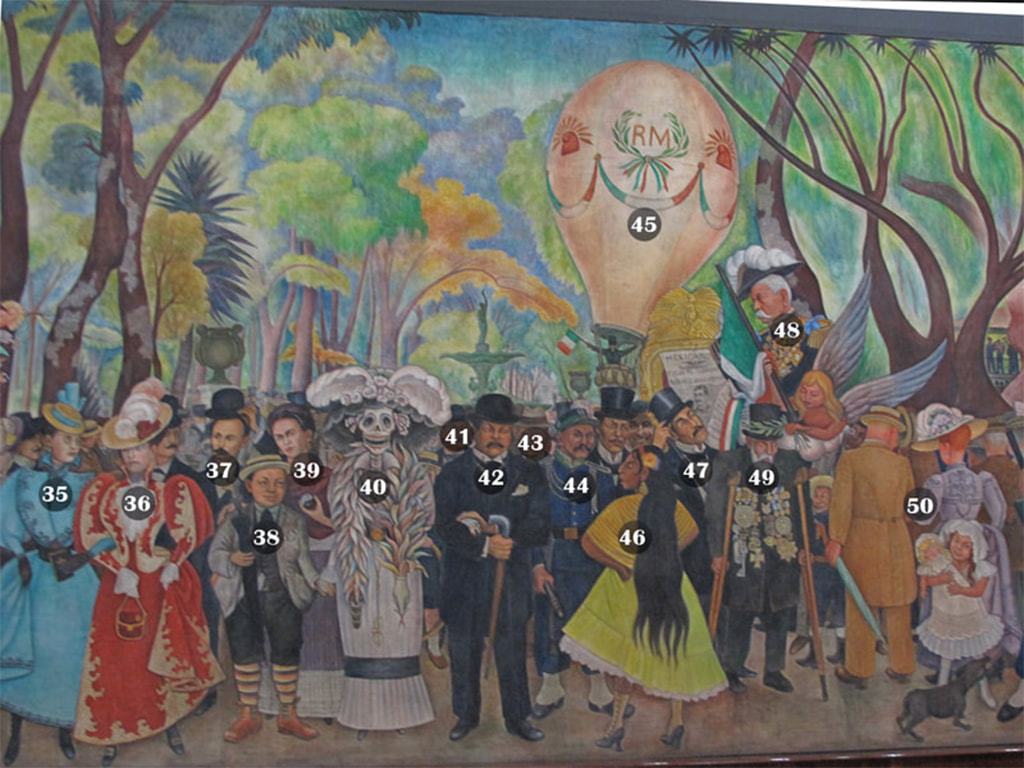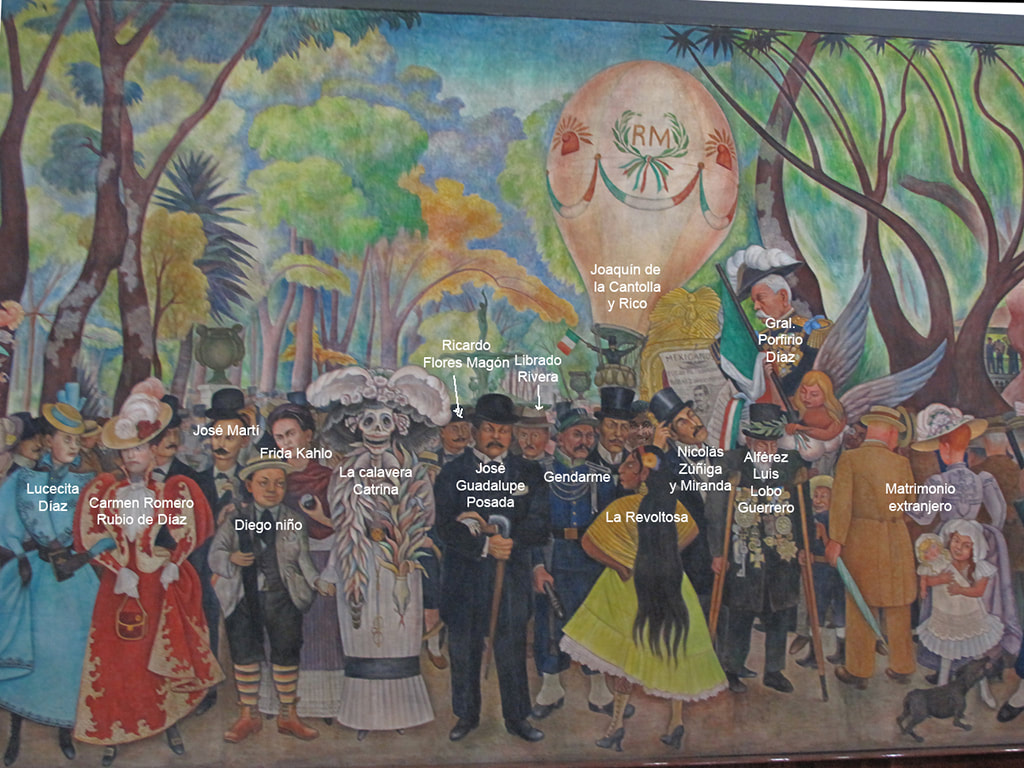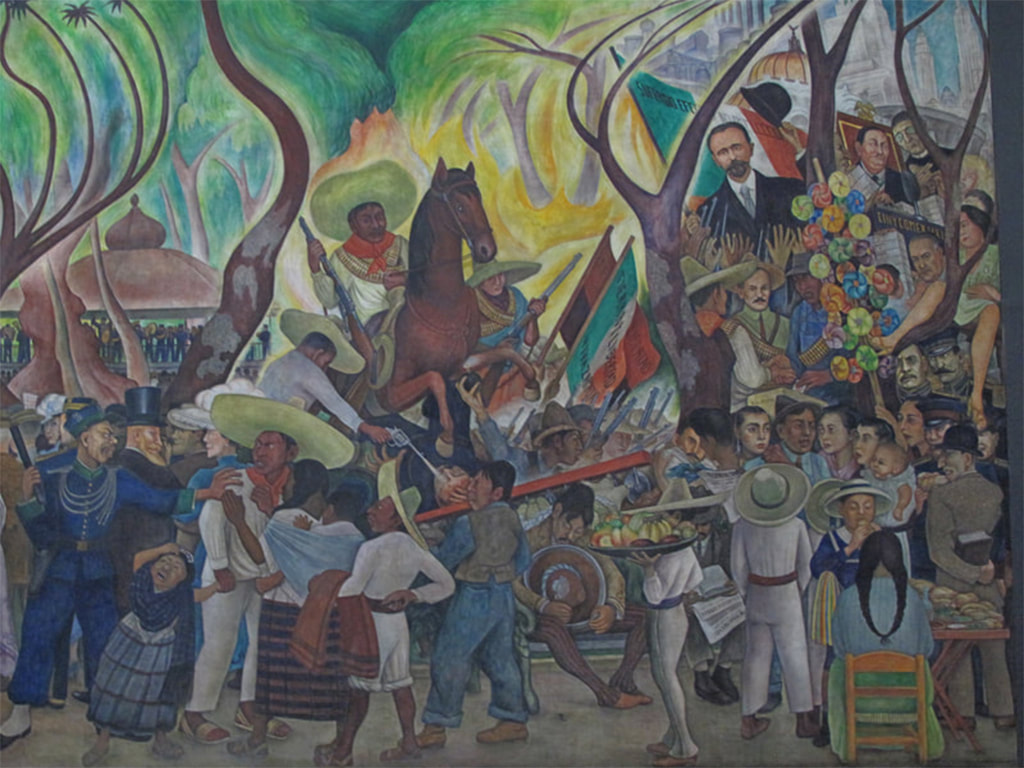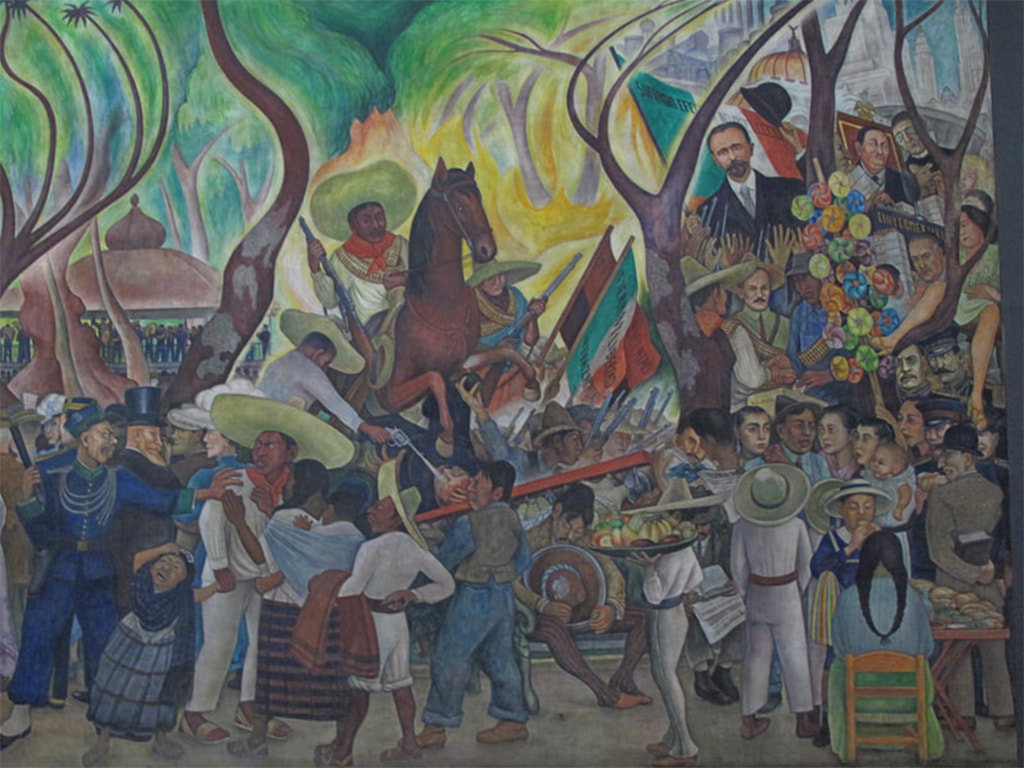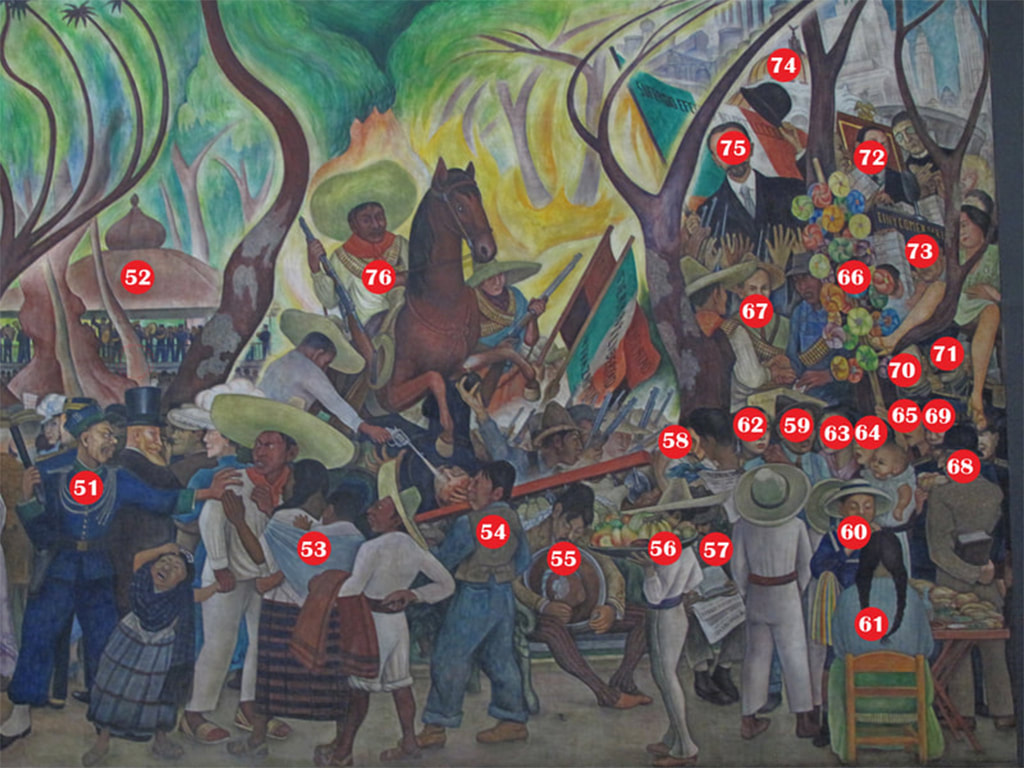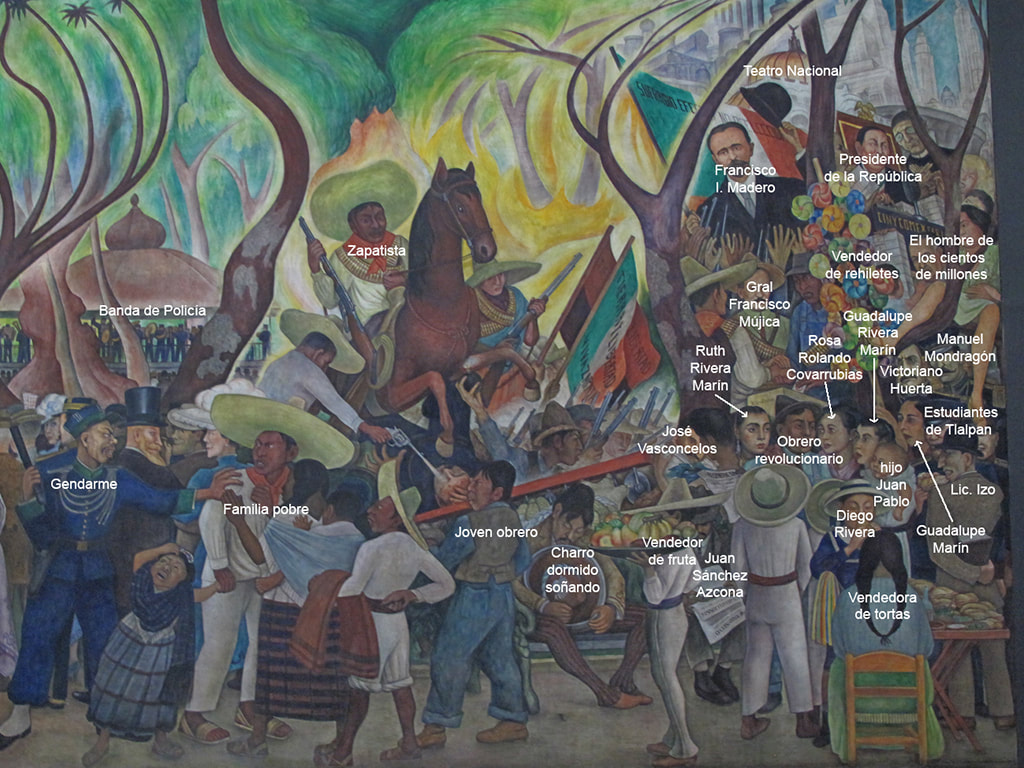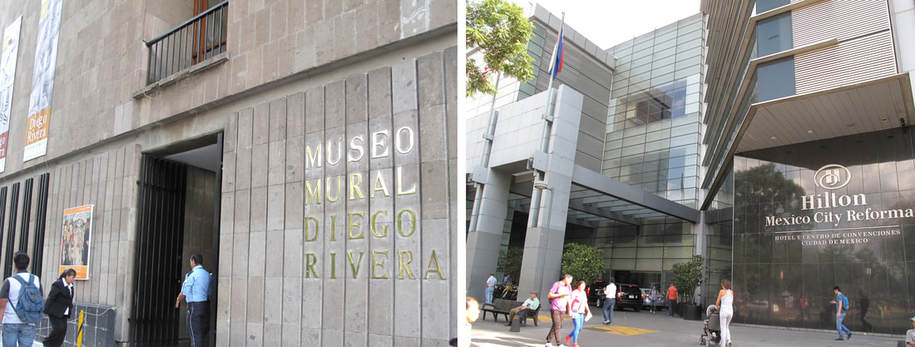DIEGO RIVERA'S MURAL
Dream of a Sunday Afternoon in the Alameda Park
Versión video of this article
|
En español
|
In English
|
Dear readers, on this occasion I want to talk about a beautiful mural that Diego Rivera painted more than 70 years ago in the lobby of the disappeared Hotel Del Prado that was located next to the Alameda Central in Mexico City.
Alameda Central Park
Alameda Central is a public park created by order of Viceroy Luis de Velasco II, in 1592 and it is considered the oldest public park in Mexico and the Americas. This area used to be an Aztec marketplace before the colonization. The Alameda name derives from the Spanish word álamo, which means grove of poplars.
Alameda Central Park
Alameda Central is a public park created by order of Viceroy Luis de Velasco II, in 1592 and it is considered the oldest public park in Mexico and the Americas. This area used to be an Aztec marketplace before the colonization. The Alameda name derives from the Spanish word álamo, which means grove of poplars.
Across the street, on the south side of Alameda Central Park, there was the Hotel Del Prado, which during its construction, Diego Rivera was commissioned to decorate a wall of its restaurant. The theme of the painting would be that of the Alameda Central. Therefore, in 1947, Diego painted the mural “Dream of a Sunday Afternoon in the Alameda Central” (Sueño de una tarde dominical en la Alameda Central) on a wall of the mentioned hotel.
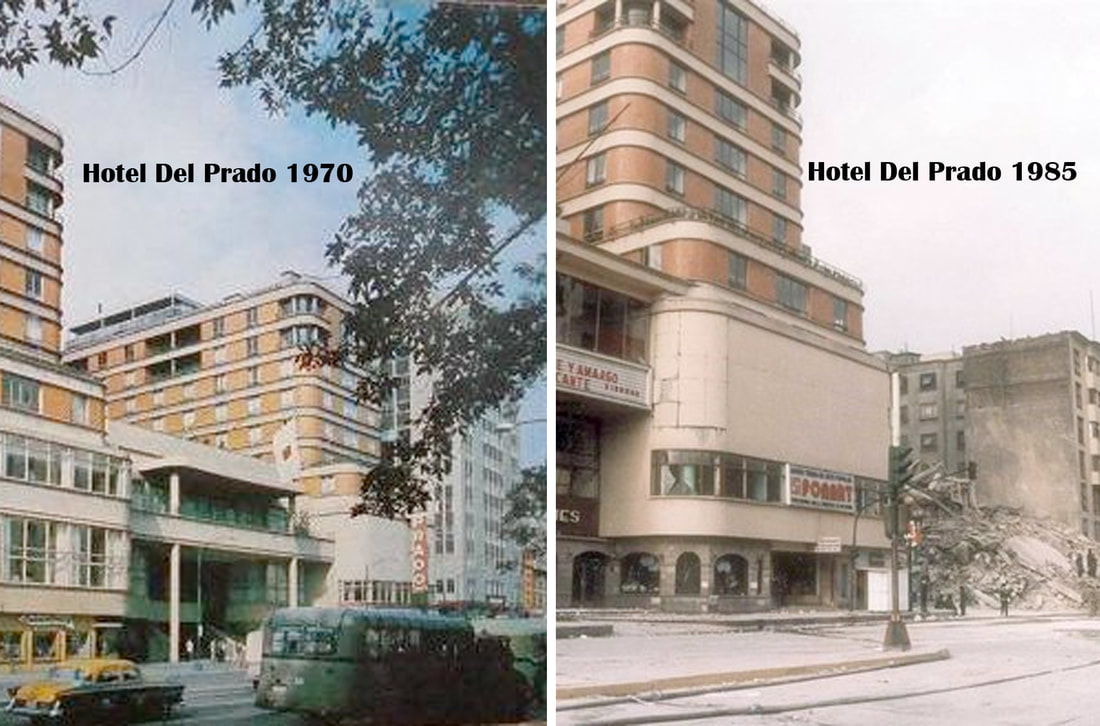
The Hotel Del Prado suffered severe damage during the 1985 Mexico City earthquakes and had to be demolished. However, the mural did not suffer serious damage and it was moved to a more appropriate place for its restoration. During its transfer, the enormous monument, which is about five meters high and fifteen long and weighs about 35 tons, was covered with wooden bales and rubber mattresses to prevent damage. The crossing of about fifty meters lasted almost twelve hours. After placing the mural on the final site, the museum's building that preserves it, was built around it. Today, in the place where the Hotel Del Prado was located, there is a luxurious hotel of the Hilton chain.
Work of remembrance
Diego Rivera represents in this work the dream of being able to go for a walk on a Sunday afternoon through the Alameda Park along with approximately 150 emblematic characters of the History of Mexico. The Mexican artist evokes in his work the most important protagonists in the history of the country who visited through the Alameda Park. That is, all the elements represented in this mural have to do, somehow, with the 400 years of history of this beautiful garden. The Alameda Central was traditionally the Sunday meeting center of the Mexican bourgeoisie. However, by the end of the 19th century, the park become popular with all social classes. The artist offers us a very subjective vision of those people who visited this elegant park. His figures move, enjoy, suffer, and argue, but above all, they dream with a better Mexico under the leafy trees of the famous park.
Elements and characters
The illustration describes the events chronologically, starting at the far left with the conquest of New Spain, ending at the far right with modern post-revolutionary Mexico.
In the upper part of the wall, the most significant buildings that surround the Alameda are represented at different stages of its existence. On the left, the church of San Diego and the Morisco kiosk are represented. On high, but to the extreme right, the modern Mexico, where we can recognize the National Theater (later Palacio de Bellas Artes), the Bullring, the Bank of Mexico and other buildings that could be seen from the park.
Diego Rivera represents in this work the dream of being able to go for a walk on a Sunday afternoon through the Alameda Park along with approximately 150 emblematic characters of the History of Mexico. The Mexican artist evokes in his work the most important protagonists in the history of the country who visited through the Alameda Park. That is, all the elements represented in this mural have to do, somehow, with the 400 years of history of this beautiful garden. The Alameda Central was traditionally the Sunday meeting center of the Mexican bourgeoisie. However, by the end of the 19th century, the park become popular with all social classes. The artist offers us a very subjective vision of those people who visited this elegant park. His figures move, enjoy, suffer, and argue, but above all, they dream with a better Mexico under the leafy trees of the famous park.
Elements and characters
The illustration describes the events chronologically, starting at the far left with the conquest of New Spain, ending at the far right with modern post-revolutionary Mexico.
In the upper part of the wall, the most significant buildings that surround the Alameda are represented at different stages of its existence. On the left, the church of San Diego and the Morisco kiosk are represented. On high, but to the extreme right, the modern Mexico, where we can recognize the National Theater (later Palacio de Bellas Artes), the Bullring, the Bank of Mexico and other buildings that could be seen from the park.
Left sector of the Mural: Conquest, Colony, Independence, American invasion and French intervention
Among the most significant personages appear: Hernán Cortés, with the hands stained with indigenous blood; Fray Juan de Zumárraga, first bishop and founder of the Holy Inquisition in Mexico; Sor Juana Inés de la Cruz, poetess and precursor of the struggle for women's rights; Luis de Velasco II, eighth Viceroy of New Spain and founder of the Alameda Central in 1592. Then the periods of independent Mexico, liberalism and the Second Mexican Empire come. These stages are represented by Agustín de Iturbide, emperor of independent Mexico; Benito Juárez, president of Mexico; Emperor Maximilian and his wife Empress Carlota.
In the same sector, the Mexican president López de Santa Anna is in front of the American General Scott, whose troops occupied Mexico City and encamped precisely in the Alameda Central during the American invasion from 1846 to 1848.
Among the most significant personages appear: Hernán Cortés, with the hands stained with indigenous blood; Fray Juan de Zumárraga, first bishop and founder of the Holy Inquisition in Mexico; Sor Juana Inés de la Cruz, poetess and precursor of the struggle for women's rights; Luis de Velasco II, eighth Viceroy of New Spain and founder of the Alameda Central in 1592. Then the periods of independent Mexico, liberalism and the Second Mexican Empire come. These stages are represented by Agustín de Iturbide, emperor of independent Mexico; Benito Juárez, president of Mexico; Emperor Maximilian and his wife Empress Carlota.
In the same sector, the Mexican president López de Santa Anna is in front of the American General Scott, whose troops occupied Mexico City and encamped precisely in the Alameda Central during the American invasion from 1846 to 1848.
Click on the small photos to identify characters
Central Section of the Mural: the Porfiriato
In the central part, Diego Rivera appears as a child, a mischievous little boy who has a toad and a snake in his pockets. The characters in the foreground refer to the immediate memory of Rivera's life. Rivera combines characters from everyday life of every moment with main passages from the history of Mexico. There is the newspaper seller El Imparcial, the most important of the Porfirista regime. There is also the globero, a typical seller of colored balloons on Sundays, the caramelero selling lollipops. Among the most significant characters are Manuel Gutiérrez Nájera, poet and forerunner of modernism in America. He carries a camellia flower in his lapel and greets José Martí, a prominent poet and father of the independence of Cuba who lived in Mexico for almost two years having a large participation in the Mexican letters.
There are two elegant women: Lucecita Díaz, woman in blue, is daughter of Porfirio Díaz and his first wife. The woman in red is Mrs. Carmen Romero Rubio de Díaz, the dictator's second wife. This section shows figures of the upper class, elegantly dressed for a walk in the park under the complacent gaze of the ruling dictator Porfirio Díaz.
In the center of the mural, Diego pays tribute to José Guadalupe Posada, to who considered his plastic master. The Catrina, an elegantly dressed skeleton, dominates the sector. She is taking the arm of her creator Posada in black suit and stick. The Catrina carries a feathered Serpent around her shoulders, a divinity present in the mythology of numerous pre-hispanic cultures of Mesoamerica. To her right, Catrina takes by the hand Diego Rivera with shorts, in a child’s version of the painter. Rivera's wife, Frida Kahlo, is just behind him holding in his hand a representation of Yin and yang.
In the central part, Diego Rivera appears as a child, a mischievous little boy who has a toad and a snake in his pockets. The characters in the foreground refer to the immediate memory of Rivera's life. Rivera combines characters from everyday life of every moment with main passages from the history of Mexico. There is the newspaper seller El Imparcial, the most important of the Porfirista regime. There is also the globero, a typical seller of colored balloons on Sundays, the caramelero selling lollipops. Among the most significant characters are Manuel Gutiérrez Nájera, poet and forerunner of modernism in America. He carries a camellia flower in his lapel and greets José Martí, a prominent poet and father of the independence of Cuba who lived in Mexico for almost two years having a large participation in the Mexican letters.
There are two elegant women: Lucecita Díaz, woman in blue, is daughter of Porfirio Díaz and his first wife. The woman in red is Mrs. Carmen Romero Rubio de Díaz, the dictator's second wife. This section shows figures of the upper class, elegantly dressed for a walk in the park under the complacent gaze of the ruling dictator Porfirio Díaz.
In the center of the mural, Diego pays tribute to José Guadalupe Posada, to who considered his plastic master. The Catrina, an elegantly dressed skeleton, dominates the sector. She is taking the arm of her creator Posada in black suit and stick. The Catrina carries a feathered Serpent around her shoulders, a divinity present in the mythology of numerous pre-hispanic cultures of Mesoamerica. To her right, Catrina takes by the hand Diego Rivera with shorts, in a child’s version of the painter. Rivera's wife, Frida Kahlo, is just behind him holding in his hand a representation of Yin and yang.
Click on the small photos to identify characters
Right Sector: modern Mexico
In the upper part of the right sector, the historical figures of Mexico of the 20th century appear, while in the lower part, the common people of the town. This sector evokes the peasant movements, the popular struggle and the Revolution. Key characters in the history of Mexico interact with ordinary people. It is observed how an indigenous family is forced to leave the Alameda by law enforcement so as not to disturb good people. With this scene, Diego makes evident his criticism of racism in Mexico.
Above a tree, Francisco I. Madero greeted people taking off his hat. The traitors of the Mexican Revolution, General Victoriano Huerta and Manuel Mondragón, responsible for the murder of Madero and Pino Suárez during the Ten Tragic Days, are also represented at the far right of the mural. Juan Sánchez and, the first secretary of Public Education, José Vasconcelos, are in the background.
At the end of the mega painting, Diego Rivera portrays himself again. In this self-portrait, the painter poses next to his family: wife, daughters, grandson, and close friends. He is eating a “torta de jamón”, a typical Mexican sandwich.
Click on the small photos to identify characters
Freedom of expression and censorship
Although Rivera respected the main theme about Alameda Central in his drawings, the artist freely expressed other ideas in his drawings, which not everyone agreed. In fact, his work just finished was censored for containing a phrase that said: "God does not exist." For several years the painting was in the hotel lobby covered with a blanket. Until in 1956, it was finally uncovered when the artist changed the framed phrase of "God does not exist" by "Conference at the Academy of Letrán, the year 1836". In the end, Diego got his way, because the new phrase was almost a synonym for "God does not exist", since in 1836, Ignacio Ramírez (The Nigromante), notable liberal thinker, being a student read a speech at the Conference of the Academy of Letrán on such a controversial issue that had the effect of a bomb at that time. There he said: «There is no God; the beings of nature support themselves ».
Although Rivera respected the main theme about Alameda Central in his drawings, the artist freely expressed other ideas in his drawings, which not everyone agreed. In fact, his work just finished was censored for containing a phrase that said: "God does not exist." For several years the painting was in the hotel lobby covered with a blanket. Until in 1956, it was finally uncovered when the artist changed the framed phrase of "God does not exist" by "Conference at the Academy of Letrán, the year 1836". In the end, Diego got his way, because the new phrase was almost a synonym for "God does not exist", since in 1836, Ignacio Ramírez (The Nigromante), notable liberal thinker, being a student read a speech at the Conference of the Academy of Letrán on such a controversial issue that had the effect of a bomb at that time. There he said: «There is no God; the beings of nature support themselves ».
La del estribo (Last before leaving)
To say goodbye, I allowed myself to transcribe for all of you the list of characters displayed to museum visitors. If you come to Mexico one day, do not forget to visit the Diego Rivera Mural Museum on the western side of the Alameda Central. You will appreciate this work and many others. Worth it!
- Mr. José María Vigil y Robles, historian and director of the National Library, dreaming about the past and evoking the history of the Alameda Park.
- Mr Guillermo W. De Landa y Escandón, governor of Mexico City, in part of the Porfirio Díaz regime.
- Don Jesús Luján, wealthy Lagunero, friend and protector of artists, especially of Julio Ruelas.
- Hernán Cortés, Spanish conqueror of Mexican territory.
- Luis de Velasco II, eighth Viceroy of New Spain. In 1592 he founded the Paseo de la Alameda.
- Fray Juan de Zumárraga, first bishop and first archbishop of New Spain. In 1539 he ordered a grandson of Netzahualcoyotl to be burned alive by idolatry, who thus became the first victim of the Inquisition in New Spain.
- Burner of the Holy Inquisition. It was installed on the land belonging to the Convent of the Dieguinos (17th century) that later became part of the Alameda Central.
- Mrs Mariana Violante de Carvajal, a beautiful Jew belonging to the famous family who was tried and sentenced to the stake for the Inquisition, under the accusation of heresy.
- San Diego Church, with a single tower, whose construction was completed in 1621, changing its facade at the beginning of the 19th century.
- Sor Juana Inés de la Cruz, the most notable poetess of New Spain during the colony, who deserved the name of “the Tenth Muse”. She declared the right of women to culture and dissent, which is why it is one of the precursors of the struggle for women's rights.
- Raterillo (young pickpocket) dreaming about the food he will buy with the product of his theft.
- Old man asleep in a once-elegant outfit, who dreams in his idyll to the sound of a waltz, remembering his Serene Highness Mr. Antonio López de Santa Anna.
- Antonio López de Santa Anna, general and politician who held the presidency of Mexico eleven times, between 1833 and 1855. As a result of the opposition to Santa Anna granting land to the United States in 1847, Mexico, in 1848, lost 51% of its territory, because of the American invasion.
- Winfield Scott, an American general whose troops occupied Mexico City and camped at the Alameda Central during the invasion of the United States Army, from 1846 to 1848.
- Agustín de Iturbide, a realistic soldier who helped to consummate independence and commanded the Trigarante army at its entrance to the capital of Mexico in 1821. For ten months he was emperor of Mexico, from 1822 to 1823.
- Morisco Pavilion. Engineer and architect José Ramón de Ibarrola project. It was in the Alameda Central and was later transferred to the Alameda de Santa María la Ribera to give his place to the Hemicycle to Juarez.
- Elderly widow dreaming of the love she had with one of the American invaders, from whom she had a blond son.
- Coarse drunk dreaming in his glories when he was a liberal Chicano.
- Mr. Benito Juárez, national hero and President of Mexico (1857-1872) during the Three Years War (1858-1860) and the French intervention (1863-1867). He deserved the distinction of Benemérito de las Américas.
- Ignacio Altamirano, novelist and radical member of the Congress of the Union. He reached the rank of colonel during the French intervention.
- Ignacio Ramírez, the Necromancer, notable liberal thinker, who in 1836, being a student, declared that "God does not exist" at the Conference of the Academy of Letrán.
- Leonardo Valle, a young liberal soldier who fought the Americans (1847) and the rebels of Puebla (1856). He participated in the Three Years War ascending to general. In 1861 he was a federal deputy and commander of the Federal District, fighting the conservatives he was apprehended and shot on the Monte de las Cruces on June 23.
- Old former conservative soldier dreaming of the second empire.
- Empress Carlota, wife of Maximilian of Habsburg. She ordered the arrangement of the Alameda due to the bad conditions in which he was.
- Maximilian of Habsburg, Austrian nobleman named emperor by Mexican conservatives and supported by the French army, from 1864 to 1867. He was shot on the Cerro de las Campanas, by order of Benito Juarez.
- General Mariano Rodríguez, officer of the guard of Empress Carlota and uncle of Diego Rivera.
- General Miguel Miramón, collaborated with the Empire and was shot along with Maximiliano.
- François Achille Bazaine, marshal of foreign troops during the French intervention.
- General Mariano Escobedo, a Republican military officer to whom Maximiliano surrendered his sword at the site of Querétaro.
- Newspaper seller selling "El Imparcial", one of the most important newspapers of the time.
- Globero, a typical Sunday character offering his colorful balloons.
- Dulcero selling typical sweets: muégano, nut swarm, pepitoria, etc.
- Caramelero offering his merchandise: lollipops, among which there are jinetes, corazones, damas, chiles verdes and rojos and the lira of poeta.
- Manuel Gutiérrez Nájera, the Duke of Job, a precursor poet of modernism in America. He founded the magazine Azul.
- Lucecita Díaz, daughter of Don Porfirio and his first wife, Delfina Ortega.
- Carmen Romero Rubio de Díaz, second wife of Porfirio Díaz and daughter of Mr. Manuel Romero Rubio, Minister of the Interior of the Porfiriato. To represent them, Rivera took her aunts Vicenta and Cesárea as models.
- José Martí, a prominent poet and father of the Independence of Cuba, who lived in Mexico from February 1875 to the end of December 1876. He had a notable activity in those two years in Mexican letters, relating to the most renowned writers of the time. In 1894 he made a quick trip to raise funds for the invasion for the independence of his native island under Spanish rule. He died in the combat of the savannah of Dos Ríos on May 19, 1895.
- Diego Child, self-portrait of the painter, who was represented by the hand of Death Catrina and dreaming of the love par excellence, which is personalized by Frida Kahlo.
- Frida Kahlo, a Mexican painter who was married to Rivera for twenty-five years. She carries in her hand the Chinese symbol of Yin and yang.
- The Catrina skull, a character created by the engraver José Guadalupe Posada, whom Rivera represented with a feathered snake that is nothing more than Quetzalcoatl, the feathered snake of pre-Hispanic cultures. Thus He worships Tonantzin.
- Ricardo Flores Magón, editor of Regeneración, liberal antiporfirist publication and precursor of the Mexican Revolution through the Liberal Party (founded in 1906), whose organizers, in addition to him, were his brother Enrique, Anselmo L. Figueroa, Pranxedis G. Guerrero and Librado Rivera. Indomitable anarchist, persecuted for his political ideas, died in prison in the United States.
- José Guadalupe Posada, extraordinary engraver who illustrated the popular publications of Mexico prior to the Revolution, and whom Diego Rivera always considered as an important teacher in his plastic training. One of his most famous creations was the Calavera Catrina.
- Librado Rivera, a very close collaborator of Ricardo Flores Magón, who suffered persecution and imprisonment like all members of the Liberal Party, to which he belonged. Friend and faithful follower of the anarchist ideas of Flores Magón, in 1918 he was sentenced along with him to suffer long sentence.
- Gendarme taking care that the "decent people" can travel quietly without mixing with local people.
- Joaquín de la Cantolla y Rico, restarted hot-air ballooning in the capital of the Republic in 1863 (they began in 1784 and were banned in Mexico City in 1862). He dreams of his Mexican Republic balloon, in which he ascends waving a tricolor flag.
- La Revoltosa, a legitimate, caricortada and gargantuan chiutlahua, who faces the gendarme who closes her way so that she does not disturb the “decent” people who walk in the Alameda. In this figure Rivera paid tribute to one of his loves, a famous treble.
- Nicolás Zúñiga and Miranda, eternal candidate for the Presidency of the Republic during the Porfiriato. He dreams that the dictator will deliver the presidential chair, the tricolor band and the glory.
- Mr. Porfirio Díaz, general and politician who held the Presidency of the Republic for thirty years.
- Ensign Luis Lobo Guerrero, nicknamed General Medals. People's hero during the American invasion. He became a characteristic character of the Paseo de la Alameda, of the children and pranksters who decorated him with bright objects.
- Foreign marriage with two children who make fun; the boy, General Medals, the girl of a small indigenous woman who cries because they take her with her family out from Alameda.
- Gendarme that prevents a peasant family from passing through the Alameda, "reserved for the well-off classes" by forcefully expelling it.
- Police band playing at the Alameda kiosk.
- Poor family that is forced out. Its members dream of the struggle to claim their rights. The father and mother appear as revolutionaries and the son shoots at the repressor.
- Young worker who is expelled along with the peasant family. He dreams of participating in the popular struggle that will bring down Porfirian feudalism. The Alameda trees, which in the far left exhibit peaceful foliage, in this section charge dynamic rhythms that frame the wave of violent color that emanates from the dreams of the represented characters.
- Asleep charro dreaming of good corn crops thanks to the help of a disc plow, with many pesos and a pulque bottle.
- Fruit seller offering his merchandise.
- Juan Sánchez Azcona, writer, journalist and maderista revolutionary, founder of the México Nuevo and the Nueva Era and collaborator of Anti reeleccionista. He is dreaming of José Vasconcelos in a radical change for the country.
- José Vasconcelos, prominent politician and Mexican writer, intellectual author of the so-called Renaissance of Mexican muralism; During his management as rector of the University and first Minister of Education, he invited several painters, including Rivera, to decorate the walls of the preparatory school (Old School of San Ildefonso).
- Revolutionary worker who speaks to young women and men of the petty bourgeoisie and craftsmen about the revolutionary ideas published in Regeneración, edited by Ricardo Flores Magón, where the ideal of “Land and Freedom” of the Liberal Party is explained by Lázaro Gutiérrez de Lara, one of the precursor ideologues of the Mexican Revolution, which would explode in 1910. This character is represented by Manuel Martínez, who was Diego Rivera's personal assistant for years.
- Middle class boy eating a sandwich. Here Diego Rivera returns to self-portrait, dreaming of what his family would be: wife, daughters and grandson, as well as close friends.
- Saleswoman of tortas (traditional Mexican sandwiches) that are sold to the middle class boy, a law student and two students of the old School of Aspirants of Tlalpan.
- Ruth Rivera Marín, daughter of Diego and Lupe Marín, his second wife.
- Rosa Rolando Covarrubias, Rivera's great friend and wife of also the painter Miguel Covarrubias.
- Guadalupe Rivera Marín, eldest daughter of Diego and Lupe Marín. She carries his little son Juan Pablo in her arms.
- Guadalupe Marín, second of the four wives Rivera had throughout his life and mother of Ruth and Guadalupe.
- Seller of rehiletes that elevates its merchandise.
- General Francisco Mújica. Participant of the Constituent Congress of 1917. Fundamentally, his work focused on Articles referring to issues of religion, politics, economy and education of the Constitution.
- “Lic. Izo ”(law student), greedily painted on his face, symbolizes the “fossil”of Law (eternal student) that dreams of making a great political career without scruples, enriching himself and obtaining immense power.
- Students of the School of Aspirants of Tlalpan with uniform of the military establishment, dreaming of the traitors and murderers Victoriano Huerta and Manuel Mondragón, and the plans of the counterrevolution.
- Victoriano Huerta, General who ordered the execution of Madero and José María Pino Suarez to usurp the Presidency of the Republic.
- Manuel Mondragón, general accomplice of Huerta who sent federal forces against Madero during the Ten Tragic Days. Father of Nahui Olin.
- President of the Republic (probably Plutarco Elías Calle or Miguel Alemán), Dispatching on the safe of Cinycomex, S.A. from R.I. (Incorporated of Unlimited Resources), handling immense amounts of money and caressing a young blonde with the consent of their advisors, one of them an archbishop (Luis Gonzaga María Martínez).
- The man of the hundreds of millions, according to Rivera's definition (probably General Maximino Ávila Camacho, Engineer Alberto J. Pani? or General Juan Andreu Almazán), hugs a young woman who is perched on a tree (the young bourgeois tree), while with the other hand he holds a high stack of bills. A little boy gives him his arms almost hidden behind the rehiletes (symbol of the inconstancy and versatility of politicians). The lady of the tree pushes with one of her feet the reed of the rehiletes. "This lady is happy and heiress of hundreds of millions, the culmination of the revolutionary family and the" pendant "of Violante Carvajal ...".
- Modern Mexico, where you can recognize the National Theater (after Palacio de Bellas Artes), the Bullring, the Bank of Mexico and other high-rise buildings.
- Francisco I. Madero, head of the movement that overthrew Porfirio Díaz and initiator of the Mexican Revolution. President of Mexico from 1911 to 1913, killed during the Ten Tragic Days by order of Victoriano Huerta.
- Zapatista, participant of the Mexican Revolution, follower of Emiliano Zapata (revolutionary leader promoting agrarian reform, who proclaimed the Ayala Plan in 1911).




